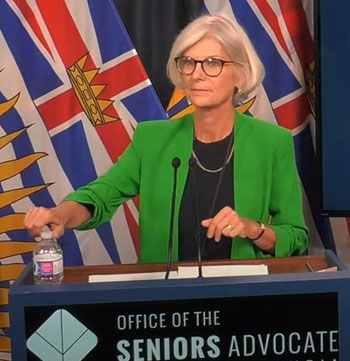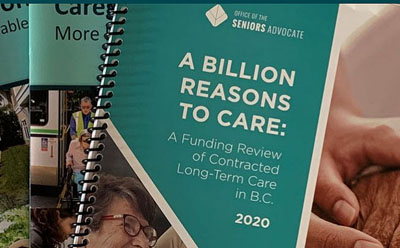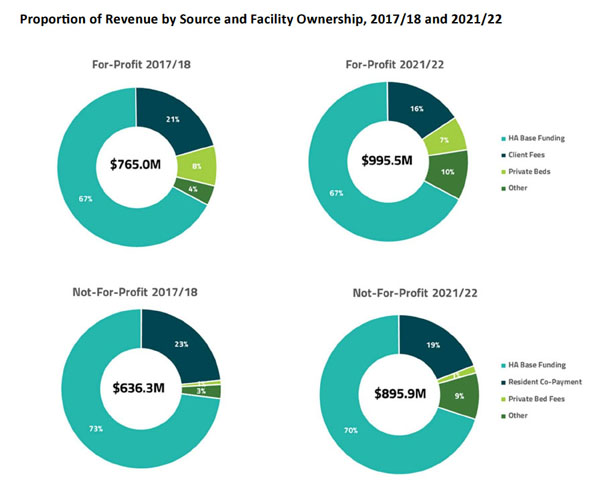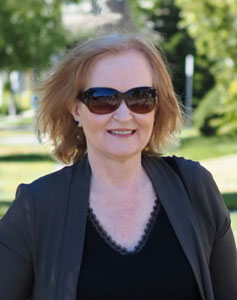Monday September 25, 2023 | VICTORIA, BC
by Mary P Brooke | Island Social Trends
Today BC Seniors Advocate Isobel Mackenzie released a new report entitled Billions More Reasons to Care Contracted Long-Term Care – Funding Review Update.
“Ask for it back, is how you would recover it,” said Mackenzie today regarding what her latest facts and figures reveal is a significant profit (and/or misuse of funds intended for direct care) by for-profit long-term care facilities.
She identified a persistent and consistent pattern of not-for-profit long-term care facilities providing more care (often even more than funded for) than for-profit places that often under-deliver on care. It’s costing more to deliver care to the same number of people, she stated.
As well, she says that the provincial government is taking too long to deal with inequities and financial loss. She noted that the $2 billion per year that is transferred from government to the private sector for long-term care is “one of the largest transfers” of government funds on an annual basis.
“By acting now, we can help ensure British Columbians receive the same high quality long-term care no matter which publicly subsidized long-term care facility they call home,” Mackenzie said.
There are about 28,000 publicly subsidized long-term care beds in BC. Of those, over 65% are contracted with the public sector, the BC Seniors Advocate said today.
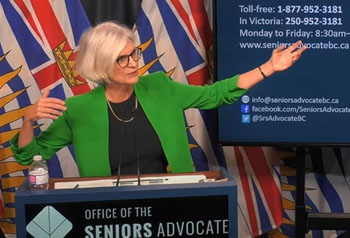
Patterns identified:
The report found patterns of spending were different in for-profit facilities compared to not-for profit facilities including:
- Not-for-profit facilities spent 25% more on resident direct care and 27% more on indirect care than for-profit facilities;
- For-profit facilities spent 66% more per bed on building costs than not-for-profit facilities;
- For-profit facilities earned 7 times as much profit as not-for-profit facilities; and
- Not-for-profit facilities delivered 93,000 hours more of direct care than they were funded to deliver and for-profits delivered 500,000 hours less than they were funded to deliver in 2021/22.
Four remaining recommendations:
Her report today included four outstanding recommendations from a previous report (one recommendation has already been acted upon, i.e. introduction of a standardized financial reporting tool:
- Funding for care must be spent on care. Financial incentives are needed to ensure the money facilities receive for direct care is spent on providing direct care. If additional revenue is needed to fund other operational costs, it should not be shifted from direct care.
- Improve accuracy and transparency of monitoring and reporting for compliance with publicly funded care hours. The current self-reporting of care hours is vulnerable to inaccuracies. Multi-skilled workers, who provide both direct care and indirect care (i.e., a care aide who also does provides food services or housekeeping) could be counted as direct care hours. The current reporting system tells us how many people the facility has classified as direct care staff, how much they were paid and how many hours they worked. There is not a similar level of detail for non-direct care staffing and the system cannot accurately capture if there is a shifting of direct care staff to non-direct care jobs.
- Define profit. There is currently no standardized approach to determining what is counted as profit. The degree to which mortgages, head office allocations, management fees, subcontracting to a related company, executive compensation and financing of other businesses is providing facilities with additional net revenue is not known. A greater understanding of the details of these expenses is required to begin to address the issue of what expenditures will be allowed, what are reasonable and equitable building costs and what is a reasonable profit.
- Make revenues and expenditures for publicly funded care homes available to the public. The public is entitled to know how their money is spent. Residents and their families are entitled to access information about funding, expenditures and care hours provided by their facility.
Full report is online:
The full Billions More Reasons to Care report is posted online. Mackenzie noted that this reports — as others — are the result of the work of many people. | Direct link to the Billions More Reasons to Care report.
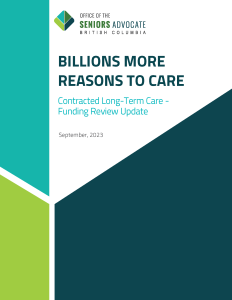
She thanked her “small but mighty team” of staffers in the Office of the Seniors Advocate, as well as the Ministry of Health and health authorities for data, and all of the long-term care facilities who provided the financial information that was requested of them.
Pandemic impacts:
“The pandemic consumed us for two years. It heightened our attention and made people aware, which is good thing,” said Isobel Mackenzie today.
There was a shift from most of the care homes not meeting 3.36 hours of care per day to almost all meeting it (during the 2017-2022 comparison time period). Some are actually in excess of 3.36, she said.
During the pandemic, not all of the care staff in care homes were paid the same, while effectively doing the same job. BC Health implemented wage levels across all classifications which Mackenzie said has stabilized the sector. She also commended the government for implementing her recommendation for a standardized template for financial reporting (which arguably made today’s new report possible).
Even during the pandemic, the proportion of funding use had not shifted. Over the last five years it’s been fairly consistent, she pointed out: about 70% on labour, 12% on buildings, 12% on supplies and administration, with 4% as profit.
Large profit gains:
Increases in expenditures were seen in direct and non direct care costs at about 33%. “That’s the bulk of the money.” Capital costs have gone up 18% over the last five years (below the overall rate of increase). Supplies and administration increased due to the need for pandemic supplies (masks, gowns, etc). The biggest surprise for the BC Seniors Advocate was the increase of profit at 113%. She feels taxpayers should want some accountability for that.
There are distinct patterns of spending by for-profit versus not-for-profit providers. “We have to pay greater attention to and address more precisely in our funding formula”.
We’re not paying the non-profit sector adequately for their buildings, but *are* paying the profit sector for their buildings.
Today Mackenzie identified that 80% of total profit in providing long-term care in BC is concentrated in 20% of the facilities. “Almost all are for-profit.” She said that the for-profit sector made 7 times the profit per bed that non-profit sector made. “This speaks to a funding formula that is not fair and equitable to all operators across the system.”
Funding must be spent on care:
“We are rewarding not spending on the care,” and “we don’t know if we’re getting value for money” she said, pointing out that there’s “not been much change over the last five years”.
“Funding for care must be spent on care. We can’t allow this drift.”

===== ABOUT ISLAND SOCIAL TRENDS:
We write about stuff that matters, so you have the information to make your own informed decisions.
News coverage on South Vancouver Island since 2008 (MapleLine Magazine, Sooke Voice News, West Shore Voice News, Island Social Trends). Editor and Publisher: Mary P Brooke, B.Sc., Cert PR.


